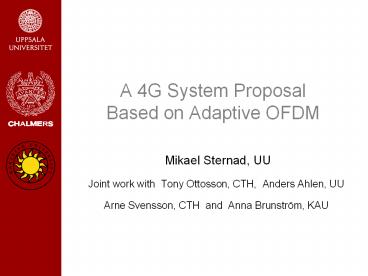A 4G System Proposal Based on Adaptive OFDM - PowerPoint PPT Presentation
1 / 18
Title:
A 4G System Proposal Based on Adaptive OFDM
Description:
Interference control (smart antennas etc. ... Smart Antennas: Simplest Case. MRC in mobile stations (MS) ... 16 dB / receiver antenna and info symbol (same ... – PowerPoint PPT presentation
Number of Views:87
Avg rating:3.0/5.0
Title: A 4G System Proposal Based on Adaptive OFDM
1
A 4G System Proposal Based on Adaptive OFDM
- Mikael Sternad, UU
- Joint work with Tony Ottosson, CTH, Anders
Ahlen, UU - Arne Svensson, CTH and Anna Brunström, KAU
2
The Wireless IP Project
- Part of SSF PCC 2000-2002
- A SSF funded project2002-2005
- Vinnova funding
- www.signal.uu.se/Research/PCCwirelessIP.html
3
Visions and Goals
- A flexible, low-cost general packet data system
allowing wide area coverage and high mobility
(vehicular velocities) - Perceived performance of 100 Mbit/s Ethernet
- High spectral efficiency (10 fold increase vs.
3G) - Quality of service and fairness
- Leads to an extreme system based on adaptive
resource allocation
4
Design concepts
- Use short term properties of the channelinstead
of averaging (predictive link adaptation) - Interference control (smart antennas etc.)
- Scheduling among sectors and users (combined MAC
and RRM) - Cross-layer interaction(soft information)
5
Short-term Channel Properties
- Typical time-frequency channel behavior (6.4 MHz,
50 km/h) - Data from Stockholm, Sweden _at_1900MHz (by
Ericsson)? Accurate channel prediction is needed
Coherence bandwidth 0.6 MHz
Coherence bandwidth 4.9 MHz
6
Channel Prediction
7
Adaptive Modulation and Prediction Errors
- Modify thresholds to keep BER constant
(single-user)
8
Smart Antennas Simplest Case
Fixed lobes (sectors, cells) at base stations
- MRC in mobile stations (MS)
Advantages BS Efficient use of space
(robust) Low interference levels MS Improv
ement of SNR (robust)
9
Scheduling Among Users in a Sector
- Feedback info from each mobile Appropriate
modulation level for each bin in a time slot. - Perform scheduling based on predicted SNR in bins
- ?
- For each bin let the best user transmit use
adaptive modulation and ARQ scheme - Modify to take QoS and fairness into account
1
4
3
5
2
user
freq
time
10
Minimizing Interference Among Sectors
- Exclusive allocation of time-frequency bins to
users within border zones between sectors of a
base station. - Novel freqency reuse scheme
- Multi-antenna terminals (IRC)
- (Power control)
- Slow resource reallocation
- between sites and sectors,
- based on traffic load
f
1
1
1
2
1
2
2
2
1
1
2
2
time
11
Design Example An Adaptive OFDM Downlink
- Maximize throughput. Ignore fairness and QoS
- Target speed 100 km/h large cells
? Frequency-selective fading - WCDMA frequency band (5 MHz bandwidth, 1900 MHz
carrier) - Adaptive modulation. Fixed within a bin (BPSK,
4-QAM, 8-QAM, 16-QAM, 32-QAM, 64-QAM, 128-QAM,
256-QAM) - Simple ARQ
- No channel coding
12
Physical Layer
- OFDM system with cyclic prefix yielding low
inter-channel interference - Symbol period is 111 ms (10011 cyclic prefix)
- 10 kHz carrier spacing (500 subcarriers in 5 MHz)
- Time-frequency grid 0.667 ms x 200 kHz (120
symbols/bin 4 pilots and 8 control symbols) - Channel constant within each bin
- Design target speed is 100 km/h
- Broadband channel predictor
- Accurate over ?/4 - ?/2 ? 2 - 4 slots _at_ 1900 MHz
and 100 km/h
13
Analysis of Throughput
- Simplifying assumptions
- Flat AWGN channel within each bin
Independent fading between bins - MRC with L antennas at mobiles (one sector of BS)
- Average SNR ? 16 dB / receiver antenna and info
symbol (same for all users slow power control) - Adaptive modulation. Selection based on
perfect channel prediction - K users. Fairness between users, QoS
requirements, and delay constraints
are neglected
14
Analysis of Throughput (cont.)
- Spectral efficiency (L antennas, K
users)Cyclic prefix - Pilots
15
Thresholds
Select the modulation level i as
Modulation
0 BPSK 1
1 4-QAM 2 8.70
2 8-QAM 3 13.53
3 16-QAM 4 16.89
4 32-QAM 5 20.46
5 64-QAM 6 23.59
6 128-QAM 7 26.86
7 256-QAM 8 29.94
16
Spectral Efficiency and Throughput(one sector,
16 dB)
25
20
Throughput Mbit/s
15
10
17
Observations
- Scheduling gives multiuser selection diversity
(from both time and frequency selectivity of the
channels) - MRC leads to good initial SNR
- Good spectral efficiency improvement already at
low to moderate load (users) - Not all bins can be used in every sector due to
interference - Uplink control information is required to signal
modulation level
18
Thank you! Questions?































